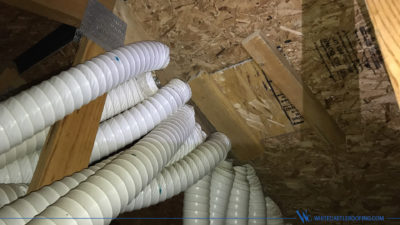Most homes have one dryer, and one dryer hoses, and one dryer vent. We fully realize this. However, the principle here is the same…

This is not a good solution for what to do with the air from your dryer.
As we all know, hot air rises. Dryers release a LOT of hot air, and it has to go somewhere, so often that’s into a flexible hose, which is released out of the house. These folks were on the right track — if the hot air is going to rise anyway, you might as well direct it toward the roof so it can be vented out the attic.
HOWEVER.
The idea is to get the air out of the house through the roof, not just under it. Releasing warm air (from a dryer — which isn’t necessarily even dry air) into an attic, especially if it’s not super well-ventilated, is an air flow nightmare. Because in the winter, what’s on the other side of that roof? Freezing cold air. What happens when warm air and cool air meet? Condensation.
As you can see, the roof deck is made of wood. Condensation on said wood means a wet roof deck. And a roof deck that’s wet for an extended period of time is a rotten roof deck. At best, those rotting wet spots will turn soft and severely compromise the integrity of your roof. But that’s not all! You can also hit the jackpot and wind up with water dripping from any exposed nails in the roof deck, and worst of all, mold.
So what’s the solution? Connect that dryer hose to a vent, whether on your roof or out your siding (depending on the placement of your dryer), and get the hot air OUT of your house, back into nature where it belongs! Building codes now actually require hoses to be connected to a vent for this very purpose. If you aren’t sure where to start with that, give us a call or request a free estimate (just select Repairs for the type of estimate you’re looking for) and we’ll be happy to come take a look and see if we can help keep your attic as dry as the Downy-fresh t-shirt you just pulled out of the dryer.